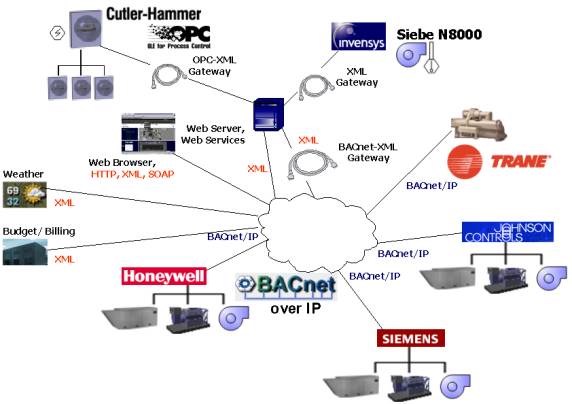A report from the BIG-NA
conference; |
Keith E. Gipson, CEO
& CTO Impact markets and implements an Enterprise Facility Management system called "myFacility". |
AutomatedBuildings.com
|
[an error occurred while processing this directive] |
A report from the BIG-NA
conference; |
Keith E. Gipson, CEO
& CTO Impact markets and implements an Enterprise Facility Management system called "myFacility". |
The convergence of Building Controls and IT, BACnet and XML are coming, and they're coming quick! The BACnet Interest Group - North America (BIG-NA) and the BACnet Manufacturer's Association (BMA) jointly hosted the BACnet Conference and Expo on October 5th, 6th & 7th, 2003 at the Kingsgate Marriott Hotel and Conference Center, on the campus of the University of Cincinnati, Cincinnati, Ohio. The Conference featured in-depth education, demonstrations, applications and hand-out materials on using the BACnet building automation and control network standard within educational institutions focusing on campus / district / and global facilities management systems and was attended by construction and facility managers and engineering consultants representing many colleges, universities, and global corporations.
It's apparent that the many years of work through groups like ASHRAE and BIG-NA are starting to pay off. BACnet has become an ANSI standard (Standard 1995-135). There is also work being done with organizations in Europe and Asia to adopt BACnet as a world standard eventually.
I had the honor of being asked to participate in one of the Technical Breakout sessions at the conference. My presentation was on leveraging Gateways Between Legacy & BACnet Systems. The Controls vendors, at a large university customer's site of ours, are providing BACnet over IP interfaces as an open Control systems integration solution. However, since some of the systems are older, legacy systems, gateways are used to supplement open protocols like BACnet. Because of this and the customer's desire to connect to non-Building Controls sources like weather, billing and scheduling, (XML) Gateways are gaining acceptance as tools that not only compliment open protocols like BACnet, but also support Enterprise applications.

The Convergence of Building Controls and IT, BACnet and XML were hot items of discussion at the BIG-NA conference this year. And although customers and vendors are starting to reap the benefits of open systems specifications and application, it was clear that there is still a lot of confusion about Building Control standards and the application of "smooth" IT interfaces. Open IT standards are a must for Building owners and managers today. BACnet is a great solution, but it was not designed for the IT web environment and is not readily integrated with other Enterprise Business systems.
|
[an error occurred while processing this directive] |
Security, by far, is the leading issue today in a company's IT infrastructure. Companies will not open proprietary ports on their corporate firewalls. So, the protocol has to be a firewall friendly protocol that's already supported like http (port 80). This is where XML comes in. XML is a machine-to-machine, communication protocol that is in use by many non-HVAC vendors today. Lots of good work has already been done by ASHRAE and the building controls industry at large and XML will not replace BACnet. However, what's needed right away are XML / Web Services functionality. There is a committee that met during the BIG-NA conference called OBIX (Open Building Information Exchange). The OBIX committee has a goal to move fast to create a non-binding guideline for the implementation of Internet standards for interoperable Enterprise Facility Management.
When trying to develop such standards, it's important to remember whom the users of these standards are going to be and how are they going to be used. Web Services can be thought of as Application Programming Interfaces (API's) that are available for use over the web. The users of any standards that get created are going to be - Corporate Developers, IT people and customers who have the ability to access and use such services, in a application development environment.
That's why we don't have to take a very long time to develop multiple functionality groups for these XML / Web Services. It is infinitely easier to access my customer's building control system using a web service, especially since my alternative is to try to figure out complicated, API calls like:
Public Declare Function OpenSystem Lib "opensys.dll" Alias "GetPointData" (ByVal nPointIDLong As Long, ByVal dwSysFunctionalityClass As Integer) As lngPtrDataStructRet
(For the sake of brevity I didn't include all the lines of code required! And that doesn't even include getting the data across the Internet, etc.)
[an error occurred while processing this directive]Alternately,
with a Web Service, the command becomes:
http://CustSite.OpenSystem.asmx/GetPointData?PointID=
CEORmTemp
The return value,
conveniently shipped back over the internet from anywhere, in XML is:
<?xml version="1.0"
encoding="utf-8" ?>
<string xmlns="http://CustSite.OpenSystem/>CEORmTemp=72.3
Deg F</string>
Any developer worth their salt could easily figure out how to implement this type of web service to get the data out of the building!
In conclusion, what is XML?
XML is the easiest, fastest and best way for vendors to expose extended functionality in their Building Controls Systems. There may be a whole "laundry-list" of functions that could eventually be developed, there are many different syntactical considerations, but start-off by giving us all the "GetPointData" web-service. There are many people out there who are ready to put it to good use, for the benefit of their customers.
[an error occurred while processing this directive]
[Click Banner To Learn More]
[Home Page] [The Automator] [About] [Subscribe ] [Contact Us]